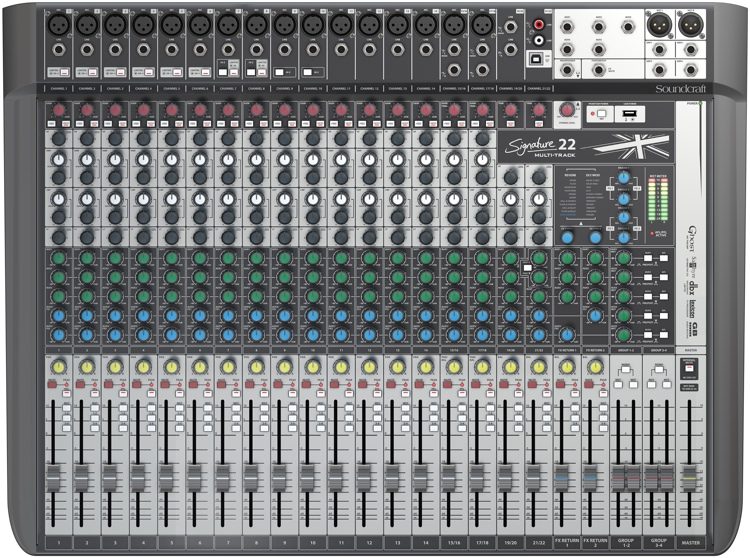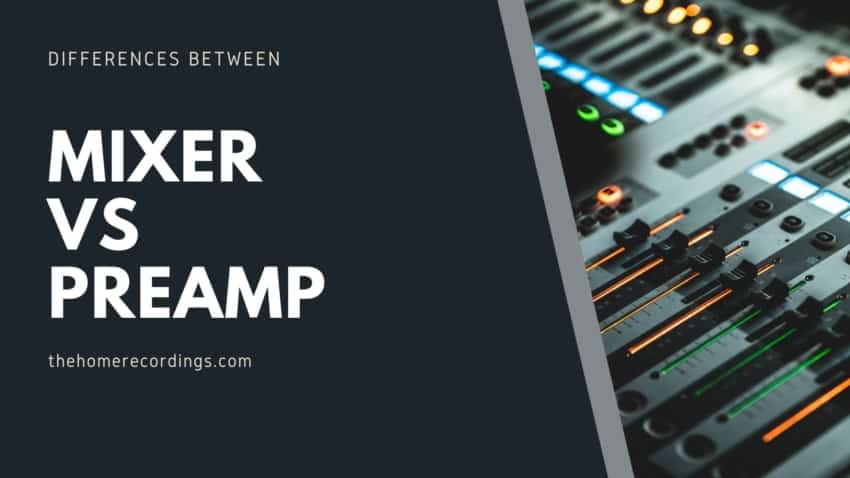I’ve seen many people ask the question of whether they should get an audio interface or a dedicated preamp, as well as if they should get a mixer or a dedicated preamp.
In this article I will do my best to explain what a mixer and what a preamp are, as well as the purpose each of them serves in a music recording environment.
So, let’s get started!
Mixer vs Preamp
A mixer is designed to mix the incoming signals together, allowing you to shape the sound using EQ, compression, etc. to create a good-sounding mix on the board itself.
A Preamp is a circuit designed to raise the signal level of a microphone to line level, which is the level required to record audio properly, and mixers do have preamps built into them.
What is a Mixer and what does it do?

Also known as Mixing Board, Mixing Console, or Sound Board, a mixer is a very versatile component that can be used from live shows to studio recordings.
At its very core, a mixer takes audio signals and mixes them together, sending them to one or more Output channels, creating a harmonious mix.
The audio comes in through the different input channels where you can adjust the volume, apply EQ, add different effects and create a monitor feed for the band members, and then that entire mix gets sent to the speakers, or PC in some cases.
Note: Mixers also come with preamps, instrument- and line-level inputs, just like audio interfaces.
The Channel strip (Set of controls per channel)
At first a Mixer might appear intimidating and confusing because it has a lot of knobs and faders.
But the good news is that these controls are divided into simple groups that are quite easy to understand;
Every channel has a complete set of controls to itself, which is called a channel strip, like Gain, Compression, EQ, AUX Sends, Volume Faders, etc.
If you know what the controls for one channel do, then you know how the controls for every other channel work, and therefore learning to use one channel strip equates to learning how the entire board works.
Different Types of Mixers
The different mixer types are; Analog, Digital, and Powered, and these can come with- or without an audio interface.
If they don’t have a built-in audio interface, then this means that they can’t be used to record audio, at least not on their own since they would need to be connected to an external audio interface.
On the other hand, mixers with an audio interface built in can be connected to a PC and will allow you to either record all of the tracks that they have available, or just the stereo output, depending on the type of audio interface they feature.
So, let’s dig in deeper!
Mixers with a built-in USB Audio Interface
Having a built-in audio interface means that you can record straight to the recording software/DAW on your PC using a mixer instead of needing a separate audio interface.
Important Note: Just because the mixer has a built-in audio interface doesn’t mean that it can record every input to a separate track in the DAW;
Most affordable mixers, say in the $200 range, will only let you record the stereo out to the PC.
This means that all the tracks coming into the mixer will be summed/mixed to one stereo file that will then be recorded, and in this case you won’t have any control over the individual tracks once they reach the PC.
On the other hand, Mixers that are capable of Multitrack recording will let you record every individual input to a separate track to the recording software.
Related: If you want to know what the best mixers are that are capable of recording multitracks over USB, then check out this article I wrote.
Mixers without a USB Audio Interface
These are the most affordable mixers on the market, but they are designed mainly with live performances in mind since they can’t record directly to a PC, pendrive, or SD card.
Now, let´s say you had a regular mixer at home, one with no multitrack capabilities, and wanted to record eight channels from it to your computer;
This would require not just the mixer, but an Audio Interface with enough inputs to record those eight tracks coming from the mixer.
While you could definitely do that, you would need eight cables going from the Mixer to the Interface, which is just a hassle and something I wouldn’t recommend.
So, getting a mixer with a built in Audio Interface, though more expensive, might be a great investment if you know how many inputs you need.
How can you tell if a Mixer can record Multi-tracks?
First, I’d highly recommend that you read the post I linked earlier about mixers that can record multi-tracks.
However, in the description of the mixer you need to look for the following things;
Some mixers are already labeled as being able to handle multitracks, like the Soundcraft Signature MTK 12, and this is a really easy way to tell.
But in most cases, you are going to need to look at the “USB Connectivity” or “Audio Interface” description of the mixer;
If it says 14-in/2-out, then this means that it will take those 14 inputs but only sum them to a stereo file.
If it says 14-in/12-out, or 14-in/14-out, then it means that it is able to record those inputs to separately.
Just as a reference, mixers under $300 usually are not capable of multitrack recording.
What is a Preamp?

A preamplifier is either the circuit within a device, such as a Microphone or Audio Interface, or it can also be a dedicated external device that has the same circuit in it, and it’s designed to raise the low signal level coming from a microphone to be able to be recorded properly, otherwise known as “line level”.
Some microphones, like the famous Shure SM7B, have such a low output that in order to get the signal to a respectable level you will need quite a powerful preamp.
In addition to this, using a high-quality preamp will not just provide you with a stable- higher-level signal, but it will also reduce unwanted noises, ending up in a much cleaner end product.
A mic preamp not only provides gain for the microphone’s signal, but it can also feed 48v phantom power to condenser microphones.
Why use a dedicated Preamp?
Preamps nowadays come in almost every piece of musical equipment on the market simply because of how useful they are, but you can also decide to purchase an external/dedicated one (Not needed for most people).
Microphones, mixers, Audio Interfaces, and other equipment generally have built-in preamps.
However, in the more affordable range, these preamps may not be that great; an example would be the ones on the Behringer UM2 Audio Interface, since if you increase the gain on the preamp, it sounds distorted, even when the audio Is not clipping (digital distortion)
The main reason to use a dedicated preamp, and it’s also why they are used in high-end studios, is to get the best-sounding recording possible.
However, there is one other very important reason to using a preamp, and that is “audio coloration”; Preamps, especially tube/valve ones, will add character to the sound, and depending on the situation this might be exactly what your music needs.
Just know that a dedicated preamp can be extremely expensive and that it’s just one piece of the puzzle to get high-quality audio.
What Types of Preamps are there?
Note: I wrote an extensive article talking about what a preamp is and all the different ones available that you should definitely check out, but here’s a quick recap:
Tube Preamps
These preamps use Valves, or Vacuum tubes, to create Gain.
These will color the sound significantly since they aren’t “transparent” like some other preamps.
Tube Preamps are known for adding warmth especially to the mids, but also body to the bass and airiness to the highs.
This warmth is added when the signal increases, because tubes tend to distort the sound a bit but in a “pleasing” way. The circuit of a tube preamp also creates some slight compression, which adds color.
Solid State Preamps
Transistors are great at creating gain with less heat, which means that as the gain increases, they can maintain very low distortion until they reach the maximum level, at which point the distortion will be extremely noticeable.
This is also known as clipping.
Digital Preamps
Digital preamps take the analog signal and convert it to a digital signal, adding their own sonic flavor in the processing before the signal is sent to the DAW.
These preamps are useful because they allow you to bypass the Audio Interface’s built-in audio conversion which tends to be inferior (usually, although in most cases it’s not a problem).
Technically you could refer to these as Audio Interfaces, since they amplify the signal and also convert it to a digital format so that your PC can record it. BUT their main focus is on the preamp!
These are all Microphone specific preamps, but there are also Instrument specific ones available that are designed to optimize the tone of a specific instrument, such as Bass Guitar, Electric Guitar, etc.
Do you need a dedicated preamp with a Mixer?
The answer in most cases would be a no, and here’s the reason behind it;
Most mixers have surprisingly good-sounding preamps in them. Getting an external preamp will be very expensive and you -most likely- won’t be able to tell the difference in the sound quality unless you have an exceptionally trained ear.
I would mostly recommend people who don’t run a super high-end studio to get a preamp ONLY if they want it to color the sound in a specific way, and even then, I don’t think it’s worth the money most of the time since there are other ways of accomplishing similar results.
How to connect an external preamp to a Mixer?
When using an external preamp, you don’t want to send that signal into the preamp of the mixer since it kind of defeats the purpose of using a dedicated one in the first place.
So, what should you do instead?…
- Connect the microphone to the XLR Input on the external Preamp.
- Connect a cable either an XLR or TRS cable to the output of the Preamp.
- That same cable should be connected to the Line inputs on the Mixer.
Conclusion
Mixers already have built-in preamps, but this doesn’t mean that dedicated preamps serve no purpose.
However, I wouldn’t recommend the average home recording enthusiast to buy one since they are quite expensive, and the overall improvement in audio quality may be barely noticeable.
I hope this information was useful!
Have a great day!
